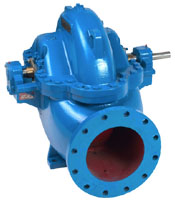Savings
Opportunities
Replace V-belts with cogged belts
Standard V-belts utilized in most motors are usually subjected to large compression stresses when conforming to the sheave diameter. Cogged V-belts have less material in the compression section of the belt, thereby minimizing rubber deformation and compression stresses on the belt. By replacing standard V-belts with cogged V-belts, the efficiency of the transmission system is estimated to increase by 3%. In addition, cogged V-belts normally last twice as long as standard V-belts. Replacing all current motor belts at one time can be expensive. Therefore, it is recommended that standard V-belts be replaced with cogged V-belts as the current belts wear out in order to achieve an attractive payback.
Use multiple speed motors or VSD for variable pump, blower, and compressor loads
A variable speed drive (VSD; sometimes called an adjustable speed drive, or ASD) can be used to control the speed of the motors used in most fans and pumps. Variable speed drives allow the motors to consume less power when less desired output is needed. This improves the system's efficiency and prevents excessive energy losses at times of low demand. VSDs can be a serious investment, and may form a significant portion of initial costs. However, enough energy savings may be realized to justify the initial costs and result in an attractive simple payback.
Downsize pumps and fans
Process requirements may change over time, so pumps should be checked periodically to ensure they are using the minimum power needed for their current use. If necessary, downsize to pumps that can maintain the required baseline operation while using less power. Oversized pumps may result in excessive energy loss. Similarly, downsize fans if possible.
Replace personal fans with HVLS fans
If facility personnel use small personal fans to cool their workspace, consider replacing these fans with high-volume low-speed (HVLS) fans. Numerous small personal fans can collectively consume a considerable amount of energy. HVLS fans operate using low horsepower motors, and can cover large areas. The energy savings can be minimal by switching to HVLS fans, and may only result in an attractive payback if numerous personal fans are currently being utilized.


